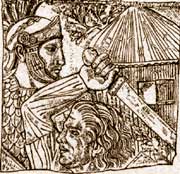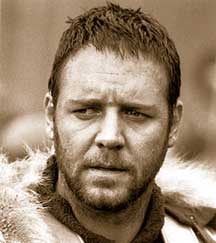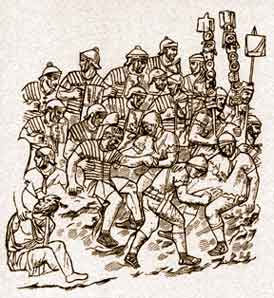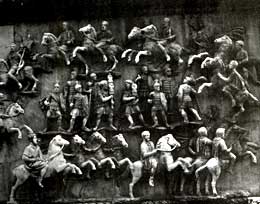|
The barbarians
began to beat upon the walls of the empire as early as AD 160....they
came on horseback, bringing new tactics for the Roman infantry to face,
and they came in masses. We may doubt if any military sustem could have
permanently stayed this series of human tides. But the Empire did what
it could....
From the
Brittanica |
The
Roman Army
In
the Roman army, the commanding officer of a legion was called the Legate.
He was assisted by a deputy called the Camp
Prefect, and a staff of six senior administrative officers called Tribunes.
The original function of the Tribunes was to spread the call to arms and
to ensure that the citizens rallied to the Eagles in time to march and
fight. Later, the Tribunate became more of a political tenure, a training
ground for young noblemen waiting to go into the consular or civil services.
Whenever a Tribune chose to distinguish himself militarily rather than
serve his time administratively and get out, his success was almost preordained.
There
were normally 28 legions in commission at any given time, and each legion
was divided into 10 cohorts. By the end of the third century, the first
two cohorts of each legion had been expanded to Millarian status, which
meant that each held 1,000 men and was the approximate equivalent of the
modern  battalion.
Prior to that time, only the First Cohort had been Millarian. To the First
and Second Cohorts fell the honor of holding the right of the legion's
line of battle, and they were made up of the finest and strongest battle-hardened
veterans. Cohorts Three through Ten were standard cohorts of 500 to 600
men. Each Millarian cohort was composed of ten maniples, and a maniple
was made up of ten squads of 10 to 12 men each. battalion.
Prior to that time, only the First Cohort had been Millarian. To the First
and Second Cohorts fell the honor of holding the right of the legion's
line of battle, and they were made up of the finest and strongest battle-hardened
veterans. Cohorts Three through Ten were standard cohorts of 500 to 600
men. Each Millarian cohort was composed of ten maniples, and a maniple
was made up of ten squads of 10 to 12 men each.
The
bulk of the legion's command was provided by the Centuriate, from the
 ranks of which came the centurions, all the middle-and lower-ranking commissioned
officers of the legion. There were six centurions to each cohort from
Three to Ten, making 48, and five senior centurions called primi ordines,
in each of the two Millarian Cohorts. Each legion had a primus pilus,
the senior centurion, a kind of super- charged Regimental Sergeant Major.
The primus pilus headed the First Cohort, the Second Cohort was headed
by the princeps secundus, and Cohorts Three through Ten were each commanded
by a pilus prior. The Roman centurion was distinguished by his uniform:
his armor was silvered, he wore his sword on his left side rather than
his right, and the crest of his helmet was turned so that it went sideways
across his helmet like a halo.
ranks of which came the centurions, all the middle-and lower-ranking commissioned
officers of the legion. There were six centurions to each cohort from
Three to Ten, making 48, and five senior centurions called primi ordines,
in each of the two Millarian Cohorts. Each legion had a primus pilus,
the senior centurion, a kind of super- charged Regimental Sergeant Major.
The primus pilus headed the First Cohort, the Second Cohort was headed
by the princeps secundus, and Cohorts Three through Ten were each commanded
by a pilus prior. The Roman centurion was distinguished by his uniform:
his armor was silvered, he wore his sword on his left side rather than
his right, and the crest of his helmet was turned so that it went sideways
across his helmet like a halo.
 Each
centurion had the right, or the option, to appoint a second-in-command
for himself, and these men, the equivalents of non-commissioned officers,
were known for that reason as optios. Other junior officers were the standard
bearers, one of whom, the aquilifer bore the Eagle of the legion. There
was also a signifier for each century, who bore the unit's identity crest
and acted as its banker. Each
centurion had the right, or the option, to appoint a second-in-command
for himself, and these men, the equivalents of non-commissioned officers,
were known for that reason as optios. Other junior officers were the standard
bearers, one of whom, the aquilifer bore the Eagle of the legion. There
was also a signifier for each century, who bore the unit's identity crest
and acted as its banker.
Each
legion also had a full complement of physicians and surgeons, veterinarians,
quartermasters and clerks, trumpeters, guard commanders, intelligence
officers, torturers and executioners.
The
Roman Cavalry
By
the end of the second century AD, cavalry was playing an important role
in legionary tactics and represented up to one-fifth of overall forces
in many military actions. Nevertheless, until the turn of the fifth century,
the cavalry was the army's weakest link. The Romans themselves were never
great horsemen, and Roman cavalry was seldom truly Roman. They preferred to
leave the cavalry to their allies and subject nations, so that history
tells us of the magnificent German mixed cavalry that Julius Caesar admired,
and which gave raise to cohortes equitates, the mixed cohorts of cavalry
and infantry used in the first, second and third centuries AD. Roman writers
also mention with admiration the light horsemen of North Africa, who rode
without bridles.
horsemen, and Roman cavalry was seldom truly Roman. They preferred to
leave the cavalry to their allies and subject nations, so that history
tells us of the magnificent German mixed cavalry that Julius Caesar admired,
and which gave raise to cohortes equitates, the mixed cohorts of cavalry
and infantry used in the first, second and third centuries AD. Roman writers
also mention with admiration the light horsemen of North Africa, who rode
without bridles.
Fundamentally,
with very few exceptions, cavalry was used as light skirmishing troops,
mainly mounted archers whose job was patrol, reconnaissance and the provision
of a mobile defensive screen while the legion was massing in battle array.
Roman cavalry of the early and middle Empire was organized in alae, units
of 500 to 1,000 men divided into squadrons, or turmae, of 30 or 40 horsemen
under the command of decurions. We know that the Romans used a kind of
saddle, with four saddle horns for anchoring baggage, but they had no
knowledge of stirrups, although they did use spurs. They also used horseshoes
and snaffle bits, and some of their horses wore armored cataphractus blankets
of bronze scales, although there is little evidence that this form of
armor, or armored cavalry, was ever widely used.
Until
the fifth century, and the aftermath of the Battle of Adrianople, it would
seem that almost no attempt had been made to study the heavy cavalry techniques
used in the second century BC by Philip of Macedon and his son Alexander
the Great. It was that renaissance, allied with the arrival of stirrups
in Europe somewhere in the first half of the fifth century, that changed
warfare forever. In terms of military impact, the significance of the
saddle with stirrups was probably greater that the invention of tank.
|
